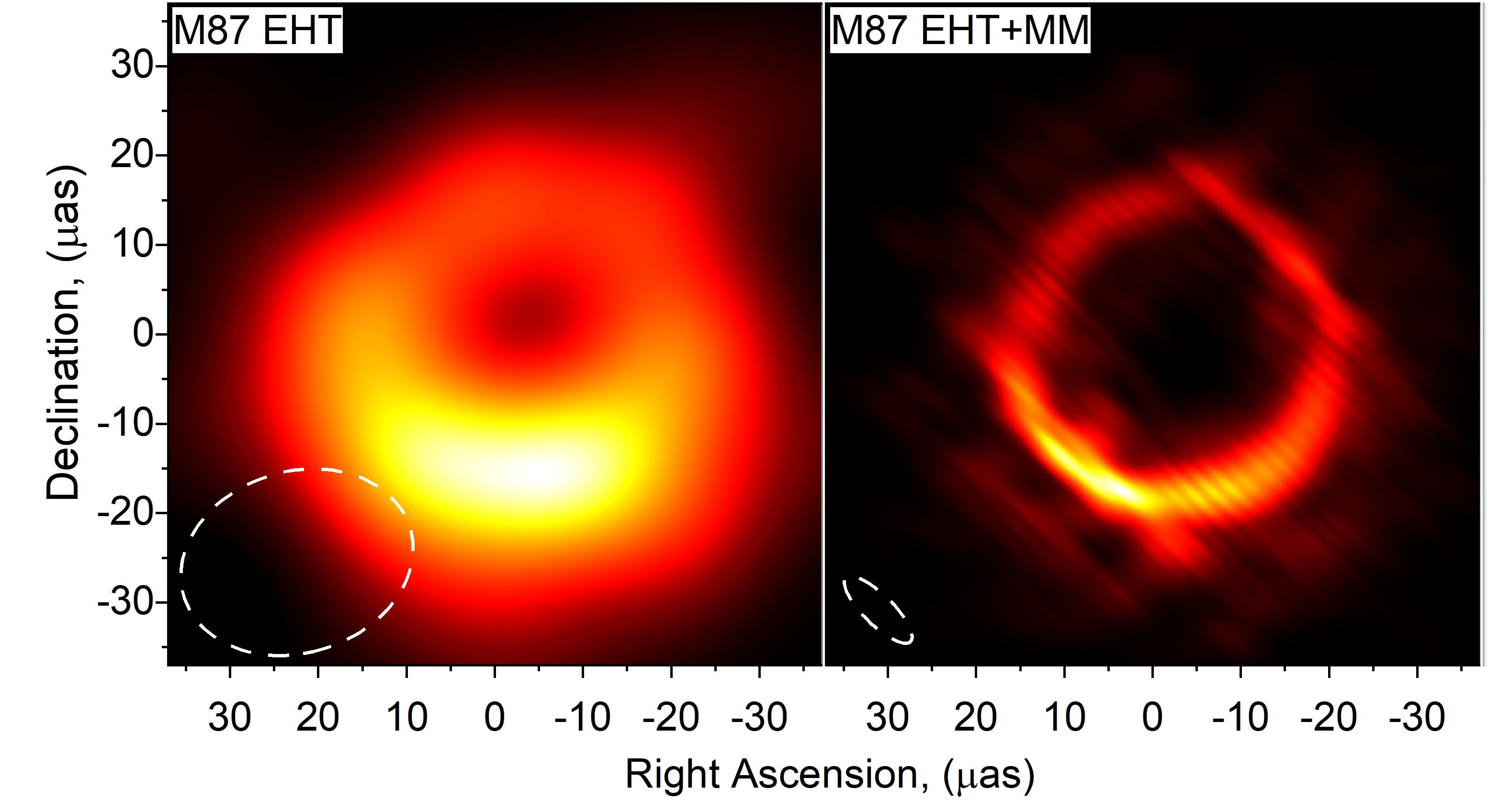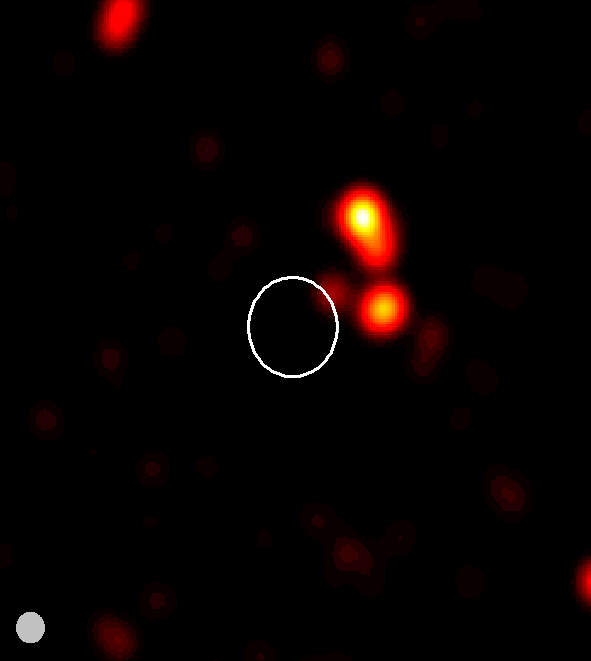A group of scientists from Astro Space Center of Lebedev Physical Institute Russia and the Netherlands evaluated the possibilities of joint observations of the Event Horizon Telescope (EHT) international network and the Millimetron Space Observatory that is currently under development. The use of the Millimetron space observatory as a part of space-ground interferometer will significantly improve the quality of images of supermassive black holes located in our Galaxy and in the galaxy M87, as well as provide the opportunity to observe the dynamics of matter movement in the immediate vicinity of the black hole event horizon. The results of the study were published in Monthly Notices of the Royal Astronomical Society.
The emission that comes from the inner regions of the accretion disk of a supermassive black hole forms an image of the so-called "black hole shadow" at distances of about 5 Schwarzschild radii. The shape that this "shadow" takes, as well as the distribution of brightness over the disk, carry information about the geometry of space-time in the immediate vicinity of the event horizon. Thus, the study of black holes makes it possible to test the theory of relativity and study the behavior of matter under extreme conditions that is unattainable in laboratories.
In April 2019, the international collaboration Event Horizon Telescope presented the first image of the shadow of a supermassive black hole located in the galaxy M87. The image was constructed from the data of radio interferometric observations with very long baselines (VLBI) of eight telescopes at a wavelength of 1.3 mm. During the observations, the highest angular resolution for ground-based observations reached 25 microarcseconds. However, its further increase is limited by the size of our planet. The way out of this situation is the development of space-ground VLBI networks.
Earlier, during the operation of the Radioastron mission, the 10-meter Spektr-R space radio telescope has been successfully observing in orbit for more than seven years. About 60 ground radio telescopes observed with the space radio telescope. The Radioastron operated in an elongated orbit with a perigee of 400 kilometers and an apogee of about 330 thousand kilometers. The observations were carried out at four frequencies: 0.3 GHz, 1.6 GHz, 4.8 GHz and 22 GHz. To date, the Radioastron has achieved the highest angular resolution - 11 microarcseconds.
The Millimetron space observatory will be equipped with an unfolding and cooled 10-meter mirror. It is planned that it will be operating at the L2 Lagrange point and will carry out observations in the far-IR, sub-millimeter and millimeter wavelength ranges. Now the observation program assumes two modes of operation. The first is the single-dish mode, in which the Millimetron will observe as a separate space telescope. In this mode it will investigate the cosmic microwave background and its spectral deviations, study the large-scale structure of the Universe, look for water and organic compounds in the interstellar medium. The second mode assumes joint observations together with ground-based telescopes as a part of an interferometer in the frequency range from 33 GHz to 720 GHz. It will study very compact astronomical objects, the study of which requires the highest angular resolution.
However, in spite of the fact that the halo orbit in the vicinity of the L2 point is very convenient for the single-dish mode, imaging of compact objects with space-ground interferometer is associated with certain difficulties. In this regard, the Millimetron project it is now considered as one of the options for optimizing the scientific program, to return the spacecraft from L2 point to the near-Earth orbit using a gravity assist maneuver near the Moon, after the end of observations in the single-dish mode.
In this new research astronomers have evaluated the quality of the reconstructed images for the case of highly elliptical near-Earth orbit. All telescopes that are currently included in the Event Horizon Telescope collaboration were considered as the ground part of space-ground interferometer. Scientists have simulated the observations of two supermassive black holes that have the largest angular dimensions in the sky - a black hole in the center of our Galaxy and in the galaxy M87. The frequency of simulated observations was 230 GHz (1.3 mm), the bandwidth was 2 GHz and the total observation time for imaging was about 15 hours. This observation time was chosen because of the limitations for the onboard memory capacity which is 100 TB. The total observation time was divided into 5400 separate observation sessions lasting 10 seconds each. The time constraint for an individual session was chosen because of the atmospheric inhomogeneities that violate the signal coherence over long time intervals.

Results of imaging simulations of the black hole shadow of the galaxy M87. On the left is an image obtained by the Event Horizon Telescope (EHT) only, on the right is an image obtained during joint observations of the Millimetron with the Event Horizon Telescope.
For M87 a segment of the orbit in the perigee region was used where the projection of the interferometer baseline changes from 0.5 to 6 Earth diameters within 20 hours. For Sgr A * the observation duration was 10 days, which corresponds to one orbital period of the space telescope. Since both sources are located in different regions of the celestial sphere, the orbit was chosen to provide the best UV coverage over the entire ten-day period for Sgr A * and good visibility for M87 with a baseline projections up to 5 Earth diameters.
The study showed that the joint observations of the Event Horizon Telescope and Millimetron will increase the angular resolution more than 6 times, reaching a record of 4 microarcseconds and also 10 times improve the quality of the reconstructed images of the supermassive black hole in the galaxy M87.This accuracy will be sufficient to analyze the shape of the black hole shadow and the brightness distribution in the inner regions of its accretion disk and directly investigate the space-time geometry and the behavior of matter in an extreme state in the immediate vicinity of the event horizon.
Also, joint observations will make it possible to obtain dynamic images of Sgr A *. The mass of a black hole in the center of our Galaxy is almost 3 orders of magnitude less than in M87. Because of this, the source has a much higher variability in time, which complicates its interferometric observations and imaging by ground-based only observatories. Due to the high velocity of the space telescope in orbit in the perigee region, the baseline projection changes from 0.1 to 1.0 of the Earth's diameter in just 20 minutes. It makes possible to reconstruct a series of images with a time interval of about 220 seconds, and will not lead to the image averaging and smearing. Thus, scientists will be able to directly observe the dynamics of the matter movement in the center of the Galaxy on a very small time scale.

Results of simulation of dynamic observations of the Galactic center (Sgr A *). A series of six frames, each about 221 seconds in duration.
The new work demonstrates the effectiveness of joint observations of the EHT ground-based millimeter network and the Millimetron space observatory in studying black holes and the properties of space-time in their immediate vicinity.
Back